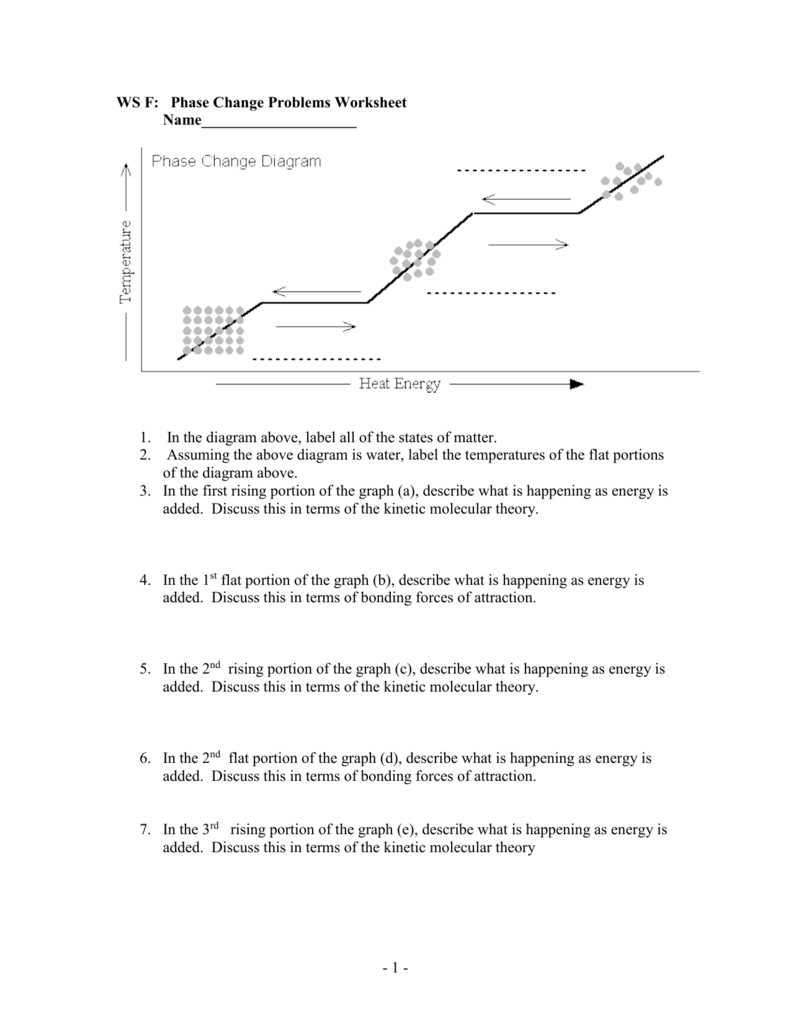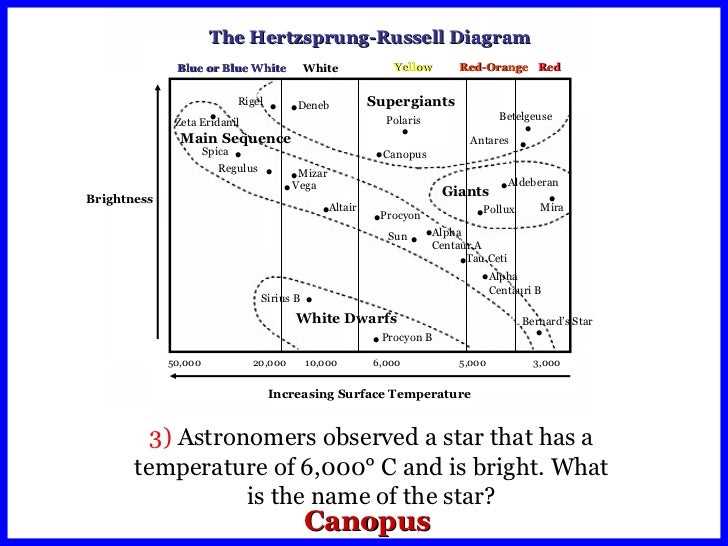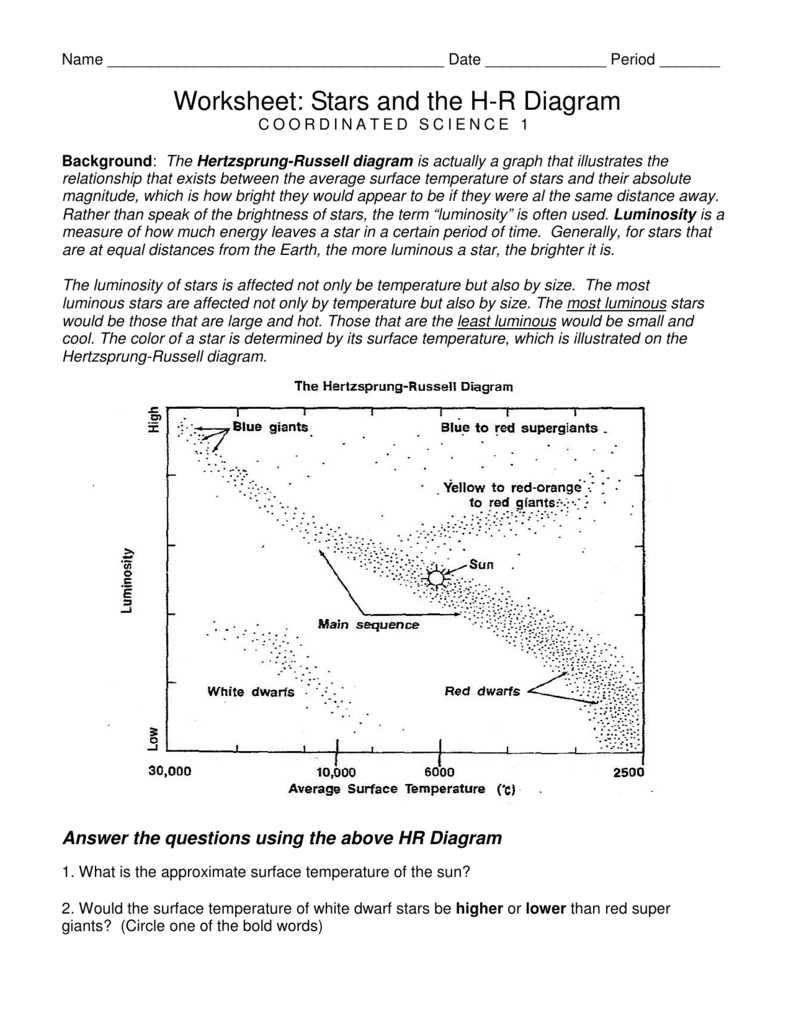
An HR diagram, also known as a Hertzsprung-Russell diagram, is a graphical representation of the relationship between a star’s luminosity (brightness) and its temperature. This diagram is widely used in astronomy to classify and understand stars. It allows astronomers to study the life cycles, evolutionary stages, and properties of stars.
Understanding an HR diagram requires analyzing the data and answering questions based on the information provided. A HR diagram worksheet in PDF format provides a set of questions and a diagram for students to evaluate and answer. These worksheets help students develop their analytical thinking skills and deepen their understanding of stellar evolution.
Answering a HR diagram worksheet involves interpreting the positioning of stars in the diagram and determining their properties. Students need to analyze the relationship between a star’s temperature and luminosity to determine its evolutionary stage, including main sequence, red giant, white dwarf, and others. By answering the questions on the worksheet, students enhance their knowledge of stellar evolution and improve their ability to interpret astronomical data.
What is an HR Diagram?

An HR (Hertzsprung-Russell) diagram is a graphical representation that showcases the relationship between a star’s luminosity (brightness) and its temperature. It is named after two astronomers, Ejnar Hertzsprung and Henry Norris Russell, who independently developed the concept in the early 20th century. The HR diagram is a fundamental tool for studying and classifying stars.
The HR diagram organizes stars based on two main characteristics: their temperature and their luminosity. Temperature is represented on the horizontal axis, with cooler stars on the right and hotter stars on the left. Luminosity is represented on the vertical axis, with brighter stars at the top and dimmer stars at the bottom. By plotting stars on the diagram, astronomers can categorize them into different groups and understand their evolutionary stages.
The HR diagram allows astronomers to identify different stellar populations, such as main sequence stars, giants, supergiants, white dwarfs, and even variable stars. Main sequence stars, which include our Sun, occupy a diagonal band stretching from the top left to the bottom right of the diagram. This band is also known as the “main sequence.” Giants and supergiants are located above and to the right of the main sequence, while white dwarfs are found below and to the left.
The HR diagram is not only useful for categorizing stars, but it also helps astronomers to study their life cycles. By comparing a star’s position on the diagram to theoretical models, scientists can determine its age, mass, and possible future evolution. The HR diagram is a powerful tool for understanding the properties and behaviors of stars in our universe.
Definition and Overview
The HR diagram, also known as the Hertzsprung-Russell diagram, is a powerful tool used by astronomers to study and understand the properties of stars. It is named after its creators, Ejnar Hertzsprung and Henry Norris Russell, who independently developed the diagram in the early 20th century. The HR diagram is essentially a graph that plots the absolute magnitude (or luminosity) of stars against their surface temperature (or spectral class).
The HR diagram provides a visual representation of the different stages of stellar evolution and allows astronomers to classify stars based on their spectral characteristics. By analyzing the distribution of stars on the diagram, scientists can infer various properties of stars, such as their mass, age, and evolutionary stage. This information is crucial in studying stellar evolution, understanding the life cycles of stars, and predicting their future evolution.
The HR diagram is constructed by plotting stars based on their observed or calculated values of luminosity and temperature. The luminosity is typically expressed in terms of absolute magnitude, which measures the actual brightness of a star from a standard distance. The temperature is usually represented by the spectral class, which characterizes the color and composition of a star.
The HR diagram is divided into several regions or zones, each representing a different stage of stellar evolution. The main sequence is the central band on the diagram, which contains the majority of stars. Other regions include the red giant branch, the white dwarf region, and the supergiant region. These regions provide insight into the different paths stars take as they evolve and eventually exhaust their nuclear fuel.
Overall, the HR diagram is a fundamental tool in astronomy that has revolutionized our understanding of stars and their properties. By analyzing and interpreting the distribution of stars on the diagram, scientists can unravel the mysteries of stellar evolution and gain insights into the dynamics and processes that shape the universe.
Importance of HR Diagrams in Astronomy
The HR (Hertzsprung-Russell) diagram is a fundamental tool in the field of astronomy. It provides a visual representation of the relationships between a star’s temperature, luminosity, and evolutionary stage. By plotting stars on this diagram, astronomers can gather valuable information about their properties and understand their life cycles.
One of the most significant aspects of the HR diagram is its ability to classify stars based on their spectral types. The diagram allows astronomers to group stars into different categories such as main sequence stars, red giants, white dwarfs, and others. This classification is crucial for studying the various stages of stellar evolution. It helps astronomers identify patterns, make predictions, and analyze the characteristics of different types of stars.
The HR diagram also plays a crucial role in determining a star’s age and its position within the galaxy. By examining a cluster of stars and plotting them on the HR diagram, astronomers can estimate the age of the cluster based on the distribution of stars along the main sequence. Additionally, the diagram provides insights into the star formation process and the evolution of galaxies.
Furthermore, the HR diagram is essential for understanding the concept of stellar nucleosynthesis and the interplay between a star’s mass and its luminosity. By analyzing the positions of stars on the HR diagram, astronomers can study the processes occurring within their cores, such as fusion reactions that produce elements like hydrogen and helium. This knowledge is vital for our understanding of the chemical evolution of the universe.
In conclusion, the HR diagram is an indispensable tool for astronomers in their quest to unravel the mysteries of the universe. It helps classify stars, determine their ages, study stellar evolution, and explore the formation and evolution of galaxies. By analyzing the data plotted on an HR diagram, astronomers can piece together the story of our universe and gain a deeper understanding of the celestial objects that inhabit it.
Studying Stellar Evolution
In order to understand the process of stellar evolution, astronomers use various tools and techniques to observe and analyze the behavior of stars throughout their lifetimes. One important tool used in studying stellar evolution is the Hertzsprung-Russell (HR) diagram. This diagram plots the luminosity of stars against their surface temperature, allowing scientists to classify and track the evolution of stars.
The HR diagram provides valuable information about the different stages of a star’s life, from its formation to its eventual death. By analyzing the positions of stars on the HR diagram, astronomers can determine their mass, age, and future evolutionary path. This helps to unravel the mysteries of how stars are born, evolve, and eventually die.
During stellar evolution, stars go through several stages, including the main sequence, red giant, and white dwarf phases. Each phase is characterized by specific changes in the star’s size, temperature, and luminosity. By studying the HR diagram, astronomers can identify these different phases and understand the physical processes that drive them.
The HR diagram also reveals the relationship between a star’s surface temperature and its color. Stars with higher temperatures appear bluer, while those with lower temperatures appear redder. This color-temperature relationship helps astronomers classify stars and study the characteristics of their atmospheres. By examining the spectra emitted by stars, scientists can gather information about their chemical composition and identify elements present in their atmospheres.
Overall, studying stellar evolution through the use of the HR diagram and other tools allows astronomers to unravel the mysteries of the universe. It provides insights into how stars are born, how they change over time, and how they ultimately meet their fate. By understanding the life cycles of stars, scientists gain a deeper understanding of the fundamental processes that shape our universe.
Determining Stellar Properties

Stellar properties, such as temperature, luminosity, and size, can be determined using various methods and observations. One of the primary tools used by astronomers to study and classify stars is the Hertzsprung-Russell (HR) diagram. This diagram plots the temperature of stars against their luminosity, providing valuable information about their characteristics and evolution.
The HR diagram allows astronomers to categorize stars into different groups based on their position on the graph. Main sequence stars, for example, occupy a diagonal band on the diagram and represent the majority of stars in the universe. The position of a star on the HR diagram can reveal its mass, radius, and stage of evolution. This information is crucial for understanding stellar processes and the life cycles of stars.
Besides the HR diagram, other methods, such as spectroscopy, are used to determine stellar properties. Spectroscopy analyzes the light emitted or absorbed by a star and can provide valuable information about its chemical composition, temperature, and radial velocity. By studying the absorption lines in a star’s spectrum, astronomers can identify elements present in its atmosphere and determine its surface temperature and chemical abundance.
Understanding the properties of stars is essential for various fields of astronomy, including stellar evolution, galactic structure, and cosmology. By studying stars and their properties, astronomers can gain insights into the formation of galaxies, the processes of nucleosynthesis, and the life cycles of stars. The HR diagram and spectroscopy are powerful tools that enable astronomers to unlock the secrets of the universe and expand our understanding of the cosmos.
Constructing an HR Diagram
The HR diagram, also known as the Hertzsprung-Russell diagram, is a graphical representation of the relationship between the luminosity (brightness) and the temperature of stars. It provides valuable insight into the evolution and characteristics of stars. Constructing an HR diagram involves gathering data on stars’ luminosity and temperature and plotting them on a graph.
To construct an HR diagram, astronomers collect data on stars’ luminosity, which is measured in terms of their absolute magnitude, and their temperature, which is usually measured through their spectral classification. These measurements can be obtained through observational techniques and remote sensing methods.
Once the data is gathered, astronomers plot the stars on an HR diagram. The temperature is typically plotted on the x-axis, and the luminosity is plotted on the y-axis. Stars with higher temperatures are located towards the left side of the diagram, while stars with lower temperatures are located towards the right side.
The HR diagram reveals several important features about stars. The main sequence, which runs diagonally from the upper left to the lower right, represents stars in a stable phase in their lives. Stars on the main sequence are fusing hydrogen into helium in their cores and have a relatively constant luminosity and temperature.
Other regions on the diagram include the giant and supergiant branches, which represent stars in later stages of their evolution. These stars have undergone significant changes in their size and luminosity. The white dwarf region represents stars that have exhausted their nuclear fuel and entered the final stages of their lives.
By analyzing the distribution of stars on the HR diagram, astronomers can study the properties and evolution of different stellar populations. The HR diagram provides a powerful tool for understanding the diverse nature of stars and the processes that govern their formation and evolution.
Plotting Luminosity and Temperature

The Hertzsprung-Russell (HR) diagram is a powerful tool used by astronomers to plot and analyze the relationship between the luminosity and temperature of stars. The HR diagram allows scientists to classify stars based on their characteristics, such as size, brightness, and stage of evolution. By plotting stars on a graph with luminosity on the vertical axis and temperature on the horizontal axis, patterns and trends can be observed, leading to a better understanding of stellar properties and evolutionary stages.
When plotting stars on the HR diagram, it is important to note that luminosity is a measure of the total energy emitted by a star, while temperature indicates the intensity of the light. The luminosity is typically measured in terms of solar luminosity, where one solar luminosity is equal to the total energy emitted by the Sun. Temperature is usually measured in Kelvin.
Stars can be classified into various regions on the HR diagram based on their luminosity and temperature. The main sequence is a diagonal band that represents the majority of stars, including our Sun. This band indicates stars that are in the main phase of their evolution, where nuclear fusion reactions occur in their cores. Giants and supergiants are located in the upper part of the diagram, representing stars that have expanded and cooled off after exhausting their nuclear fuel. White dwarfs, on the other hand, are located in the lower left region of the diagram, indicating their small size and high temperature.
The HR diagram is a valuable tool for astronomers as it allows them to compare and classify different types of stars. By understanding where a star falls on the diagram, scientists can determine its stage of evolution, estimate its size and lifespan, and make predictions about its future. This diagram has revolutionized our understanding of the life cycle of stars and continues to be a fundamental tool in the field of stellar astrophysics.